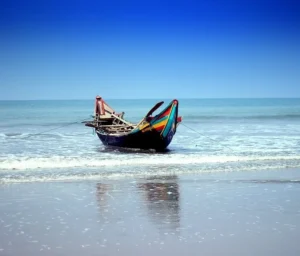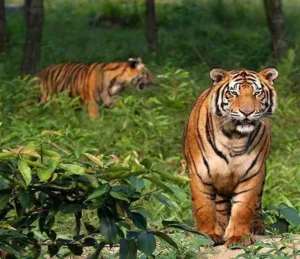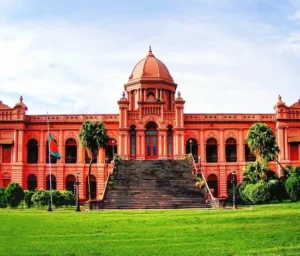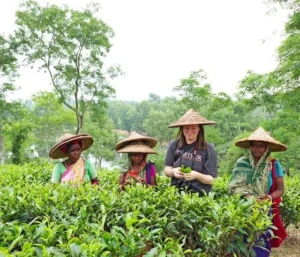Bangladesh
UTC+6 (Bangladesh Standard Time)
No daylight saving time observed
Bangladeshi Taka (BDT)
Symbol: ৳
Denominations: 2, 5, 10, 20, 50, 100, 500, 1000 taka
March 26, 1971 (from Pakistan)
Independence Day is a national holiday
Victory Day celebrated on December 16
E-visa available for many nationalities
Visa on arrival for select countries
Applications can be made through Bangladesh missions abroad
Culture
Bangladesh's vibrant culture is a product of its rich history, geographic position, and diverse influences from South Asia, the Middle East, and beyond. Despite being one of the world's most densely populated countries, Bangladesh maintains a distinct cultural identity centered around Bengali heritage.
Key elements of Bangladeshi culture include:
- Language and literature: Bengali (Bangla) is at the heart of national identity, with a rich literary tradition dating back centuries. Nobel laureate Rabindranath Tagore's works are particularly cherished.
- Religious diversity: While Islam is the predominant religion (about 90% of the population), Bangladesh embraces a secular approach with significant Hindu, Buddhist, and Christian communities.
- Arts and crafts: Traditional handicrafts include intricate embroidery work (nakshi kantha), pottery, bamboo and cane crafts, and handloom textiles, particularly muslin and jamdani.
- Music and dance: Folk traditions include Baul music (recognized by UNESCO), Bhatiali (boatmen's songs), as well as classical forms of dance like Manipuri, Kathak, and regional folk dances.
Bangladesh's cultural identity is deeply intertwined with its Liberation War of 1971, which shapes national consciousness and pride. The country celebrates Bengali New Year (Pohela Boishakh) with colorful processions, traditional foods, and cultural performances.
Bangladesh's cuisine is known for its aromatic dishes and complex flavors:
- Rice and fish: These form the staple diet, reflected in the Bengali saying "Mache Bhate Bangali" (Bengalis live on fish and rice)
- Hilsa fish: The national fish, prepared in various ways and considered a delicacy
- Biryani: Dhaka is famous for its unique style of Kacchi biryani
- Pitha: Rice cakes prepared in various forms, especially during festivals
- Sweets: Bengali sweets like roshogolla, chamcham, and mishti doi are famous throughout South Asia
Traditional festivals are celebrated with great enthusiasm throughout the country. Eid celebrations, Durga Puja, Pohela Boishakh (Bengali New Year), and various harvest festivals bring communities together in celebrations that involve special foods, music, dance, and social gatherings.
Tourism & Best Sites to Visit
Bangladesh offers visitors a less-traveled but rewarding destination with natural wonders, archaeological treasures, and vibrant cultural experiences. From the world's longest natural beach to UNESCO World Heritage sites, Bangladesh has diverse attractions for travelers.
Here are some of Bangladesh's most remarkable destinations:





Cox's Bazar Beach: The world's longest natural sea beach, stretching 120 kilometers along the Bay of Bengal. The area offers a range of accommodations, seafood restaurants, and activities like beach sports and boat trips.
Sundarbans Mangrove Forest: A UNESCO World Heritage Site, this is the largest mangrove forest in the world and home to the famous Bengal tiger. Boat tours allow visitors to explore the mysterious waterways and spot wildlife.
Ahsan Manzil (Pink Palace): Once the official residence of the Dhaka Nawab family, this striking pink palace on the banks of the Buriganga River now serves as a museum displaying artifacts from the colonial period.
Srimangal Tea Gardens: Known as the "tea capital" of Bangladesh, this area features rolling hills covered with tea plantations, offering visitors the chance to tour tea estates, visit local tribal villages, and trek through the Lawachara National Park.
Somapura Mahavihara: Another UNESCO World Heritage Site, this ancient Buddhist monastery dating from the 8th century is one of the most important archaeological sites in Bangladesh, featuring intricate terracotta decorations.
Transportation
Bangladesh has a diverse transportation network, though traffic congestion is a significant challenge, particularly in urban areas. The country's numerous rivers play a key role in its transportation infrastructure.
- Rickshaws and CNGs: Auto-rickshaws (locally called CNGs due to their compressed natural gas fuel) and cycle rickshaws are ubiquitous in cities and towns, providing affordable short-distance transportation.
- Buses: The most common form of long-distance public transportation, with services ranging from basic local buses to air-conditioned intercity coaches. Dhaka's bus system includes a Bus Rapid Transit (BRT) system being developed.
- Metro Rail: Dhaka recently opened its first metro line (MRT Line-6), marking a significant advancement in urban public transportation. Additional lines are under construction.
- Trains: Bangladesh Railway operates a network connecting major cities, though the system is gradually being modernized. Popular routes include Dhaka-Chittagong, Dhaka-Sylhet, and Dhaka-Khulna.
- Water transport: Given Bangladesh's numerous rivers, ferries and launches are essential transportation methods, particularly in the southern regions. The Dhaka-Barisal and Dhaka-Khulna water routes are popular.
- Ride-sharing services: Apps like Uber, Pathao, and Shohoz operate in major cities, offering convenient alternatives to traditional transportation options.
Note: During monsoon season (June to September), transportation can be affected by flooding in certain areas, particularly in rural regions and low-lying areas.
Airports
Bangladesh has several international and domestic airports serving different regions of the country:
- Hazrat Shahjalal International Airport (DAC): Located in Dhaka, this is Bangladesh's largest and busiest international airport, handling the majority of international flights. The airport is currently undergoing expansion with a third terminal under construction.
- Shah Amanat International Airport (CGP): Serving Chittagong (Chattogram), Bangladesh's second-largest city and main seaport, this airport handles both domestic and international flights.
- Osmani International Airport (ZYL): Located in Sylhet, this airport serves the northeastern region of Bangladesh and handles flights to and from the Middle East and United Kingdom, along with domestic routes.
- Khan Jahan Ali Airport (New Barisal Airport): A newer international airport serving the southern region.
- Domestic airports: Several smaller airports serve domestic routes, including Cox's Bazar Airport (CXB), Shah Makhdum Airport in Rajshahi (RJH), and Jessore Airport (JSR).
Airlines: Biman Bangladesh Airlines is the national carrier, operating flights to destinations in Asia, the Middle East, and Europe. Other carriers serving Bangladesh include US-Bangla Airlines, Novoair, and various international airlines.
Airport Access: Most airports are connected to city centers by taxis, CNGs (auto-rickshaws), and in some cases, bus services. In Dhaka, app-based ride-sharing services provide convenient access to Hazrat Shahjalal International Airport.
Visa & Travel Information
Most foreign nationals require a visa to enter Bangladesh, though the country has introduced e-visa and visa-on-arrival facilities to simplify the process for tourists and business travelers.
Visa options for visiting Bangladesh include:
- Tourist visa (single or multiple entry)
- Business visa
- Transit visa
- Diplomatic and official visas
- Student visa
- Work visa
E-Visa Process: Bangladesh offers electronic visa services through its official e-visa portal. Applicants need to submit passport details, travel information, a digital photograph, and supporting documents depending on the visa type. Processing typically takes 3-5 working days.
Travel Restrictions by Nationality
The following table provides general information about visa requirements for entering Bangladesh:
| Country/Region | Visa Requirement | Notes |
|---|---|---|
| India | Visa Required | Special arrangements for land border crossings |
| SAARC Countries (excluding India) | Visa Required | Simplified procedures may apply |
| Most Western Countries (USA, UK, EU, Australia, Canada, etc.) | Visa on Arrival/E-Visa Available | Eligible for visa on arrival for tourism, business, or transit |
| Middle Eastern Countries | Visa Required | E-visa available for most nationalities |
| East Asian Countries (Japan, South Korea, etc.) | Visa on Arrival/E-Visa Available | Eligible for visa on arrival for tourism and business |
| Most African Countries | Visa Required | Must apply through Bangladesh diplomatic missions |
Visa on Arrival: Available for citizens of many countries at major international airports, typically for stays of up to 30 days. Requirements usually include:
- Valid passport with at least six months validity
- Return/onward ticket
- Proof of sufficient funds for the stay
- Visa fee payment (varies by nationality)
- Two passport-sized photographs
Entry Requirements: In addition to visa requirements, travelers to Bangladesh should ensure they have:
- A passport valid for at least six months beyond their planned departure date
- Proof of accommodation arrangements
- Sufficient funds for the duration of stay
- Yellow fever vaccination certificate if arriving from affected countries
Note: Visa regulations can change, so it's advisable to check with the Bangladesh embassy or consulate in your country or visit the official e-visa portal for the most up-to-date information before planning your trip.